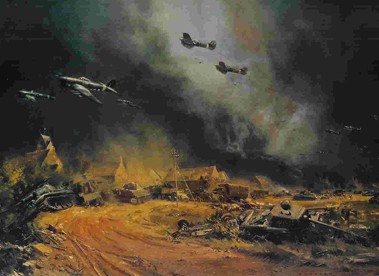

 |
|
Visit my virtual archives of many of the primary source documents this work is based upon.
|
Dedication Chapter One: Background Chapter Two: System Chapter Three: Problems Chapter Four: Practice Chapter Five: Assessment Conclusion |
How did the Allies apply their air power against the Germans in Normandy? By the time of the Normandy campaign, Allied air power was overwhelming. This has traditionally been invoked as an explanation for the eventual Allied victory. But how was this air power actually brought to bear on the German Army? In the event, it was used primarily as fire support for the Allied armies as they bludgeoned their way forward. Airpower was a powerful but generally blunt instrument for the Allies in Normandy. Fortunately, that airpower was so overwhelming that the Allies could in large part do all things at once, without being forced to make difficult choices. Really though, the Allies had not worked through the difficult questions of how best to apply airpower against an enemy army in the field. In order to understand how the Allies actually did seek to apply their airpower against the Germans, it is important to appreciate the pre-war and early-war debates over airpower, for this was a complex and difficult problem. After all, what is the most effective way to bring thousands of aircraft to bear against a powerful opponent? Attacking strong points along the front? Support and supply targets in his immediate rear? Bridges and other choke points? Strafing the roads to try and prevent movement? A complex organization -- known as the Allied Expeditionary Air Forces or AEAF -- was developed to do just this. The two centre pieces of the AEAF were the 2nd Tactical Air Force of the RAF and the US 9th Air Force. Both had intricate and highly refined procedures for planning and executing air strikes. Essentially, the Allies lacked a clear and cogent doctrine for their tactical air forces. This is hardly surprising. In the inter and early war years, all doctrinal thought had been absorded in the inter-service wars over strategic bombing. When tactical air forces were finally formed late in the day, all available effort went into rushing them into existence and solving the immediate problems of organizing a control system. No time or energy was left over for the more difficult doctrinal questions. Dedication Inter-war and early-war Background The arguments over strategic bombing leave air support to armies an orphan. The System in Normandy Under a system of "joint command" an elaborate system is created to control tactical air power. Problems At the time the Army considered the RAF unduly unresponsive to Army requirements. Many historians since have seconded this view. Practice How was tactical air power actually employed in the campaign? Mostly as fire support for the armies, or in rather free-ranging sweeps behind the lines. Assessment The system developed to control tactical air power was technically a marvel. It could indeed rapidly and concertedly apply air power against the enemy.As to accusations that the RAF was not sufficently cooperative, or responsive, this accusation would seem hollow. It is clear that air power could be quickly and effectively concentrated when wished. It is less clear that critics had a clear idea of what they wanted airpower to do to the Germans, other than to "penny packet" it out to shoot up whatever targets happened to lie along the front at any given moment. |